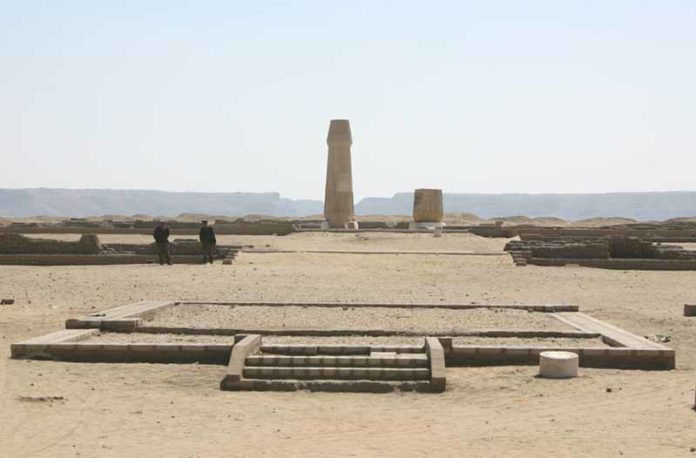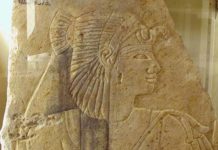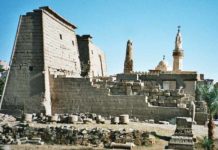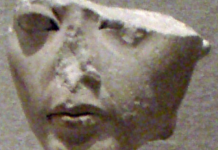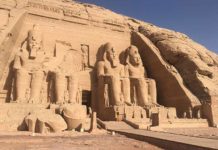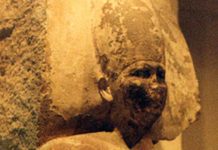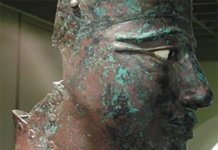In the fifth year of his reign Akhenaten, Egypt’s first and only monotheistic pharoah, moved his entire court from Karnak 230 miles north to El Amarna. He named this new city Akhetaten, which means The Horizon of the Aten. Aten was the Creator Sun God who’s influence grew during the reigns of Amenhotep II, Tuthmosis IV and Amenhotep III. It was Amenhotep IV who re-named himself Akhenaten in honour of the God.
The Site At Amarna
Peter Clayton in ‘The Chronicle of the Pharoahs’ described Amarna as an extremely important site in that it was used neither before nor since this one short span, although the Romans and Christians did have settlements nearby. The city itself is eight miles long and three miles wide, ringed by a natural amphitheatre of rock and the nile. There are fifteen large perimeter stele all showing the Aten, the Pharoah, his wife Nefertiti and his daughters. The largest of these is Stela U at 7.6 metres high and occupying almost the entire cliff face at the northern entrance to the Royal Wadi.
These stele show that Akhenaten chose the site upon instruction from Aten himself. Everything within the city was focussed upon the king, his family and Aten. There is no mention of life outside Amarna nor relating to treatment of the people – a population estimated between 25 – 50,000. Items discovered have shown that worship of the old gods did continue and it was only the upper classes that conformed totally to Aten worship.
Excavations At The Site
Excavation of the site began in 1714 by Claude Sicard, a french Jesuit priest. Napoleon had the first map of the area commissioned in 1798 and this was completed in 1824 by Sir John Gardiner, who returned later with James Burton to investigate the tombs. In 1833 Robert Hay uncovered several of the Southern Tombs and in 1843 Richard Lepsius, a disciple of Champollion, was able to decipher and record the hieroglyphs on the visible monuments and inscriptions. This work was published and allowed scholars to finally understand the significance of the site. In 1891 Alessandro Barsanti uncovered the King’s Tomb and Sir Flinders Petrie worked on the Central City. Excavations have been conducted by a series of British and German archeological teams since 1907, currently work is being led by Dr Barry Kemp.
The City Centre
Within the Central City was the Royal palace and the Great Temple, as well as the government offices. In 1887 a local woman discovered, completely by accident, a cache of over 300 cuniform tablets written in Akkadian, which are now known as the Armarna Letters. This area was well planned whilst the residential areas were not. Just south of the small Aten Temple was the main residential area occupied by people such as the Vizier Nakht, the General Rahmose, the High Priest Panehsy and architect Mankhtawitf.
The Necropolis and Royal Tombs
There are 25 tombs that face the cliff south of the Royal Wadi, six are on the northern side near Darb El-Malik and were used by the high officials. Nineteen are known as the South Tombs, one of which was built for Ay, who would become pharoah after Tutankhamen. The Royal Tomb built for Akhenaten himself lies six kilometres from the mouth of the Royal Wadi. it was obviously intended for several people but may not have been used. The rock is of poor quality and the only ddecorations remaining are in the chamber that was reserved for Princess Meketaten.
The area itself is still covered with sand and none of the stonework from the temples or palaces has survived as the city was decimated after Akhenaten’s death (or disappearance). Only sun-dried brick walls remain. An agricultural development destroyed a garden temple and another similar building was re-used by early Christians as a monastery. Cleaning and repair is ongoing in order to make the site more accessible for tourists and a model of the entire site has been completed and is on view in the Visitor Centre. It is still the only Ancient Egyptian city for which the details of the internal plan are available, however the city itself is unique and may not represent others such as Luxor and Alexandria.


